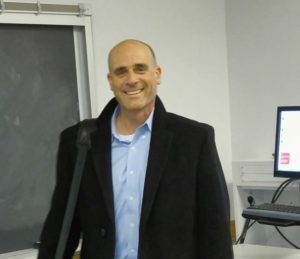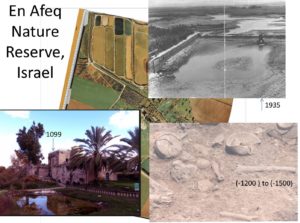
I love it all. This is probably the answer to why I teach “Ecology in War and Peace: Sustainability in the Middle East.” It’s the cultures. It’s the living biology and the physical landscape. It’s the politics. It’s the fact that there are no definite answers and so many complex connections among multiple factors. And it’s the ever-changing Middle East. The course covers the area where I grew up and even touches the Hebrew language, which I also teach at Northeastern. Holding a Bachelor’s degree in Biology and a Master’s in Geography, working for seven years in the Israeli Nature Reserve Authority, and being involved for over 30 years in Middle East politics paved the way for me to create this course.
“Ecology in War and Peace” is as an interdisciplinary course that reviews topics in ecology and the environment, connecting them to the state of Israel and the contemporary geographical, social, and political situation in the Middle East. We reviewed different conceptions of human relations with the environment. We then moved on to nature preservation practices in different eras, examining the agreements and conflicts arising between nature preservation and human activity. We looked at ways to reach sustainable development aimed at preserving natural resources for the next generations. The course connected these topics to the Middle East conflict, exploring how political and religious issues interconnect with ecology and the environment. We tried to predict the future of nature preservation in this war-torn and vibrant land, focusing on Israel, its immediate neighboring countries, and other rapidly changing political entities. Of course we failed to predict correctly, as reality is more surprising than any wild imagination or model.
As a result, teaching this course has been an exploration. Recent, rapid changes in the Middle East have made almost all previous maps, political books, and research studies invalid and irrelevant. With accurate material and research still in the process of being produced, I built the lectures on what was available and changed them as events advanced. In many cases, I had to use ongoing news, in the absence of credible and valid information, which increased my and my students’ interest. We have watched history being created in front of our eyes.
Which brings me to the students, who were the heart and soul of the course. I merely gave them a forum and a framework in which to explore. They conducted almost 30 (!) research studies and presented them in class. Their projects were innovative and imaginative, often on topics that I wouldn’t have thought could be connected to the course, such as: “Climate change & the migrant crisis”; “Contraceptive availability and its effect on resource availability”; Water as a weapon”; “Drought and migration”; and “Complex mathematical models.” It’s all there and more because ecology comprises of everything around us.
Meeting three times a week and the cooperation required among the students created a unique community. We were shocked when one of us, Priscilla Perez-Torres, who had submitted her midterm project a week earlier, was killed in a car accident in Dubai during the Spring Break. I would like to dedicate this review to her memory.
Read the rest of the Spring 2016 Haverim Newsletter here.





